Christmas Island
 From Nwe
From Nwe This article is about the Australian territory in the Indian Ocean. For the Kiritimati atoll (also known as Christmas Island) in the Pacific Ocean see Kiribati.
|
Territory of Christmas Island
|
||||
|---|---|---|---|---|
|
||||
| Anthem: Advance Australia Fair |
||||
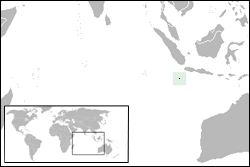
|
||||
| Capital (and largest city) |
Flying Fish Cove ("The Settlement") | |||
| Official languages | English (de facto) | |||
| Ethnic groups | 70% Chinese, 20% European, 10% Malay | |||
| Demonym | Christmas Islanders | |||
| Government | Federal constitutional monarchy | |||
| - | Monarchy | Charles III | ||
| - | Governor-General of the Commonwealth of Australia | Quentin Bryce |
||
| - | Administrator | Brian Lacy | ||
| - | Shire President | Gordon Thomson | ||
| Territory of Australia | ||||
| - | Sovereignty transferred to Australia |
1957 |
||
| Area | ||||
| - | Total | 135 km² 52 sq mi |
||
| - | Water (%) | 0 | ||
| Population | ||||
| - | 2016 estimate | 2,205[1] (230th) | ||
| - | Density | 10.39/km² (n/a) 26.96/sq mi |
||
| Currency | Australian dollar (AUD) |
|||
| Time zone | (UTC+7) | |||
| Internet TLD | .cx | |||
| Calling code | +61 | |||
The Territory of Christmas Island is a small territory of Australia located in the Indian Ocean, 1645 miles (2650 km) northwest of Perth in Western Australia, 225 miles (360 km) south of Jakarta, Indonesia and 840 miles (1350 km) South of Singapore.
It maintains about 1,500 residents who live in a number of "settlement areas" on the northern tip of the island: Flying Fish Cove (also known as Kampong), Settlement, Silver City, Poon Saan and Drumsite.
Christmas Island has a unique natural topography and is of immense interest to scientists and ecologists due to the number of species of endemic flora and fauna which have evolved in isolation, undisturbed by human habitation. This relatively small island is home to 12 diverse habitat classifications, including large areas of pristine and ancient rainforest.
While there has been mining activity on the island for many years, 63 percent of its 52 square miles (135 square km) are now protected as the Christmas Island National Park.
Geography
Christmas Island is shaped like a quadrilateral with hollowed sides, about 12 miles (19 km) in greatest length and 9 miles (14.5 km ) in extreme breadth. The total land area is 52 square miles (135 km²), with 86.3 miles (138.9 km) of coastline.
Christmas Island is believed to be moving northward on a tectonic plate at the rate of a few centimeters a year. Formation of Christmas Island, according to a commonly accepted theory is as follows:
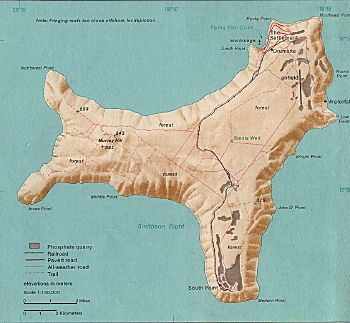
- 60 million years ago an undersea volcano rose above the level of the ocean and a coral atoll was formed.
- 20 million years ago subsidence of the atoll began and limestone accumulated as the corals sank.
- 10 million years ago a series of uplifts reversed the subsidence and Christmas Island emerged. Because theses uplifts happened on several different occasions, Christmas Island has a stepped appearance. The combined effects of the erosion of the sea cliff and each successive uplift formed each individual terrace. Examples of some of the more recent faultings and lava flows can be seen at the Dales, Dolly Beach, Egeria Point, Ross Hill Gardens, Waterfall and Winifred Beach. There are also numerous caves, typical of limestone formations throughout the island.[2]
Though most of the coastline consists of rocky, sheer cliffs ranging up to 65 feet (20 m) in height, there are also a few small sand and coral beaches along the coast. The interior is a slightly undulating plateau that ranges from 160-360 m above sea level. The central plateau is separated from the shore by a series of steep slopes or cliffs. Valuable deposits of phosphate occur on the island.[3]
Christmas Island's environment can be classified into 12 broad habitats: marine, shoreline rock platforms, beaches, sea cliffs, terrace forest, shallow soil rainforest, limestone scree slopes and pinnacles, deeper plateau and terrace soils rainforest, mangrove forest, perennially wet areas, karst, and mining fields (limestone pinnacles).[4]
Climate
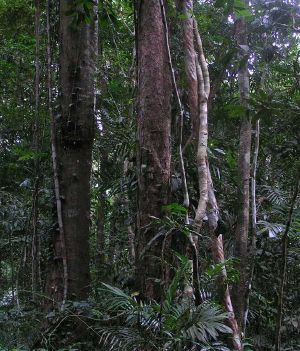
Tropical rainforest covers most of Christmas Island, which is located at the southern edge of the equatorial low pressure belt that, during the course of the year, moves north and south of the equator. The island therefore experiences a typical tropical, equatorial climate with a wet and a dry season. The wet season, when the northwest monsoons blow, is generally from December to April. Southeast trade winds bring slightly lower temperatures and humidity, and much less rain, for the remainder of the year. Average annual rainfall is 113 inches (2,670 mm).
Heavy downpours lasting several days are common during the monsoon, The island is sometimes affected by cyclones and cyclonic swells from the northwest. As with most tropical locations, humidity and temperatures vary little with humidity ranges from 80-90 percent, and temperature ranges from average maximum of 29 ºC (84 °F) in March/April to average minimums of 23 °C (73 °F) in August/September.[5]
Springs and wells provide fresh water for the island's residents. Most of the western tip of the island is a national park, while approximately 65 percent of the entire island is such.
Flora and fauna
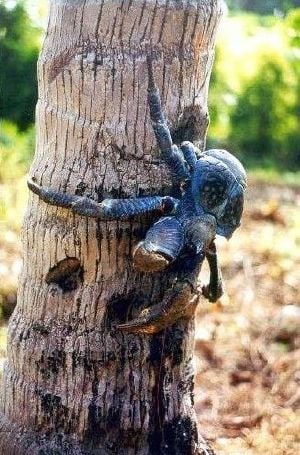

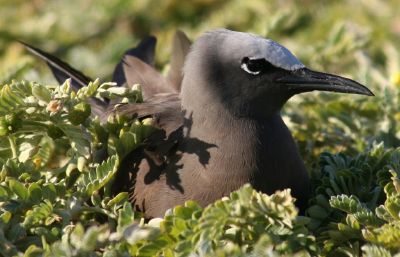
Christmas Island is of immense scientific value as it was uninhabited until the late nineteenth century; thus many unique species of fauna and flora exist which have evolved independently of human interference. Among the best-known is the Christmas Island red crab, which numbered some 100 million on the island as of 2004. Two-thirds of the island has been declared a National Park that is managed by the Australian Department of Environment and Heritage.
There are approximately 200 species of native flowering plants on the island. The distribution of these plants is related to the depth of the soil, the soil's moisture retention and exposure to and distance from the sea. The dense rainforest has evolved in the deep soils of the plateau and on the terraces. The forests are dominated by 25 tree species. Ferns, orchids and vines grow on the branches in the humid atmosphere beneath the forest canopy. The list of 16 plant species listed as endemic to Christmas Island has been increased to 18.
The annual red crab mass migration to the sea to spawn, which involves around 100 million animals, is "a truly spectacular sight," one "one of the most incredible natural processes on Earth."[6] This takes place each year around November, after the start of the wet season and in synchronization with the cycle of the moon.
The land crabs and sea birds are the most noticeable animals on the island. Twenty terrestrial and intertidal crabs (of which 13 are regarded as true land crabs, only dependent on the ocean for larval development) have been described. Robber crabs, known elsewhere as coconut crabs, also exist in large numbers on Christmas Island and are capable of opening and devouring coconuts with their strong claws.
The Island is a focal point for sea birds of various species. Eight species or subspecies of sea birds nest on the island. The most numerous is the Red-footed Booby that nests in tree colonies on many parts of the shore terrace. The widespread Brown Booby nests on the ground near the edge of the seacliff and inland cliffs. Abbott's Booby (listed as endangered) nests on tall emergent trees of the western, northern and southern plateau rainforest. The Christmas Island forest is the only nesting habitat of the Abbott's Booby that remains in the world.
The endemic Christmas Island Frigatebird (also listed as endangered) has nesting areas on the northeastern shore terraces. Great Frigatebirds nest in semi-deciduous trees on the shore terrace with the greatest concentrations being in the North West and South Point areas. The Common Noddy and two species of bosuns, or tropicbirds, with their brilliant gold or silver plumage and distinctive streamer tail feathers, also nest on the island. Of the ten native land birds and shorebirds, seven are endemic species or subspecies. Some 76 vagrant and migrant bird species have been recorded.
Protected areas

Christmas Island has a unique natural history which has been of interest since the first explorations of the island. Prior to the commencement of the mining industry a study was commissioned to evaluate its natural history. It was then determined that only limited areas would be open to mining in order to preserve its natural habitat. However, in the 1960s the island's mining area was enlarged.
In 1974 the House of Representatives Standing Committee on Environment and Conservation recommended that an area be reserved for conservation. Several years of further study followed and in February 1980 "Christmas Island National Park" was established. Since that time the area of the park has been expanded in several phases, until 63 percent of the island is now included in the preserve.
Areas included under the Park's protection include areas of freshwater mangroves and other unique vegetation, most of the remaining undisturbed rainforest, crucial areas of habitat for species such as Abbott's booby, the Christmas Island frigatebird and blue and red crabs. Off–shore areas to 50m below the water's surface are also included. The establishment of the park has provided excellent opportunities for ecological studies and the development of environmental protection.
In addition to opportunities for studies, the park also provides income to the Island through its many opportunities for eco-tourism to which people are drawn because of its unique rainforest, the variety and number of seabirds, the spectacular red crab migration and the rugged land and seascapes. [7]
History
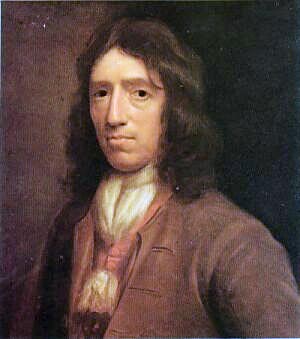
For centuries, Christmas Island's isolation and rugged coasts provided natural barriers to settlement. British and Dutch navigators first included the island on their charts from the early seventeenth century, and Captain William Mynors of the British East India Company vessel, the Royal Mary, named the island when he passed by on Christmas Day in 1643. The island first appears on a map produced by Pieter Goos and published in 1666. Goos had labeled the island Moni.
The earliest recorded visit was in March 1688 by William Dampier of the British ship Cygnet, who found it uninhabited. An account of the visit can be found in Dampier's Voyages, which describes how, when trying to reach Cocos from New Holland, his ship was pulled off course in an easterly direction and after 28 days arrived at Christmas Island. Dampier landed at the Dales (on the West Coast) and two of his crewmen were the first recorded people to set foot on Christmas Island.
The next visit was by Daniel Beekman, who described it in his 1718 book, A Voyage to and from the Island of Borneo, in the East Indies.
In 1771, the Indian vessel, the Pigot, attempted to find an anchorage but was unsuccessful; the crew reported seeing wild pigs and coconut palms. However, pigs have never been introduced to the island, so the Pigot may have been mistaken in its assumption of the island's identity.
Exploration and annexation
The first attempt at exploration of the island was in 1857 by the crew of the Amethyst. Trying to reach the summit of the island, they found the cliffs impassable.
During the 1872-76 Challenger expedition to Indonesia, naturalist Dr. John Murray carried out extensive surveys.
In 1887, Captain Maclear of HMS Flying Fish, having discovered an anchorage in a bay which he named Flying Fish Cove, landed a party and made a small but interesting collection of the flora and fauna. In the next year, Pelham Aldrich, on board HMS Egeria, visited the island for ten days, accompanied by J. J. Lister, who gathered a larger biological and mineralogical collection.
Among the rocks then obtained and submitted to John Murray for examination were many that were nearly–pure phosphate of lime, a discovery which led to annexation of the island by the British Crown on June 6, 1888.
Settlement and exploitation
Soon afterwards, a small settlement was established in Flying Fish Cove by G. Clunies Ross, the owner of the Cocos (Keeling) Islands (some 900 kilometers to the southwest), to collect timber and supplies for the growing industry on Cocos.
Phosphate mining began in the 1890s using indentured workers from Singapore, China, and Malaysia.
The island was administered jointly by the British Phosphate Commissioners and District Officers from the United Kingdom Colonial Office through the Straits Settlements, and later the Crown Colony of Singapore.
Japanese invasion
During World War II, many of the European residents of Christmas Island were evacuated in anticipation of a Japanese invasion. Japan invaded and occupied the island in 1942, as the Indian garrison mutinied, and interned the residents until the end of the war in 1945. For a short time following the war, Christmas Island came under the jurisdiction of the new Colony of Singapore.
Transfer to Australia
At Australia's request, the United Kingdom transferred sovereignty to Australia in 1957. The Australian government paid the government of Singapore £2.9 million in compensation, a figure based mainly on an estimated value of the phosphate foregone by Singapore.
The first Australian Official Representative arrived in 1958 and was replaced by an Administrator in 1968. Christmas Island and the Cocos (Keeling) Islands together are called the Australian Indian Ocean Territories and since 1997 have shared a single Administrator resident on Christmas Island.
Since the late 1980s or early 1990s Christmas Island periodically received boatloads of refugees, mostly from Indonesia. Early in the twenty-first century, John Howard, the Australian Prime Minister, passed legislation through the Australian Parliament which excised Christmas Island from Australia's migration zone, meaning that asylum seekers arriving there could not automatically apply to the Australian government for refugee status, allowing the Australian navy to relocate them to other countries (Papua New Guinea's Manus Island, and Nauru) as part of the so-called Pacific Solution.
Government
Christmas Island is a non-self governing territory of Australia, administered by the Australian Department of Transport and Regional Services (DOTARS). The legal system is under the authority of the Governor General of Australia and Australian law. An Administrator appointed by the Governor-General of Australia represents the monarch and Australia.
The Australian Government provides Commonwealth-level government services through the Christmas Island Administration and DOTARS. Together with the Cocos (Keeling) Islands, Christmas Island forms the Australian Government's Indian Ocean Territories (IOT).
The Christmas Island Act 1958, administered by the Australian Federal Government's Department of Transport and Regional Services on behalf of the Minister for Local Government, Territories and Roads, provides the legislative basis for the Territory's administrative, legislative and judicial system. The Minister is responsible for the State-level services in the Territory.
Christmas Island residents who are Australian citizens also vote in Commonwealth (federal) elections. Christmas Island residents are represented in the House of Representatives through the Northern Territory electorate of Lingiari and in the Senate by Northern Territory Senators.
State government
There is no State Government; instead, state government type services are provided by contractors, including departments of the Western Australian Government, with the costs met by the Australian (Commonwealth) Government.
Local government
The Local Government Act 1995 (WA), (CI) was introduced in 1992. The first Shire Council was elected in 1993. The Shire Council has the same responsibilities as a local government on the Australian mainland. A unicameral Shire of Christmas Island with 9 seats provides local government services and is elected by popular vote to serve four-year terms. Elections are held every two years, with half the members standing for election.
In early 1986, the Christmas Island Assembly held a design competition for an island flag; the winning design was adopted as the informal flag of the territory, and in 2002 it was made the official flag of Christmas Island. The blue and green triangles represent the sea surrounding the island and the vegetation of the island, respectively. The Southern cross in the blue triangle is the representation appearing in the Australian flag. The image in the green triangle is the Golden Bosun Bird, which is unique to the island. The gold disk in the center of the flag represents the island's phosphate mining history and was originally included to provide a background for the green map of Christmas Island.
The Australian Federal Police (AFP) are responsible for providing police services to the Community of Christmas Island. No firearms are allowed on the Island. In addition to the normal police functions the AFP carry out other duties including immigration, processing of aircraft, visiting ships and yachts; and co-ordination of emergency operations.
Economy
Phosphate mining was once the only significant economic activity, but in December 1987 the Australian Government closed the mine. In 1991, the mine was reopened by a consortium which included many of the former mine workers as shareholders. With the support of the government, a $34 million casino opened in 1993. The casino closed in 1998 and has not re-opened. The Australian Government in 2001 agreed to support the creation of a commercial space-launching site on the island, however this has not yet been constructed, and appears that it will not proceed in the future.
Government and transport also contribute significantly to the economy. The Government sector includes administration, health, education, policing and defense.
Tourism, hospitality and retail trade is an important income earner.
Demographics


The ethnic makeup of the population of Christmas Island is diverse. The first settlement of the Clunies-Ross family included Javanese as well as Cocos-Malay people. When the island's mine was established Chinese laborers were brought in, as well as workers from Java and Ambon. Mine supervisors came from India. Today, the majority of inhabitants are born to families who live on Christmas Island, many of Chinese and Malay origin. However, since 1998 there has been no provision for childbirth on the island, which means expectant mothers travel to mainland Australia approximately one month before their expected date to give birth, and return up to a month afterwards.[8]
Religions practiced on Christmas Island are diverse and Buddhism, Christianity, Taoism, Islam, and Confucianism. English is the official language, but Chinese and Malay are also spoken.
Education
The Christmas Island District High School provides education from pre-school level through to Year 12 secondary level. The school is staffed by teachers from the Education Department of Western Australia and follows the state curriculum.
There is one public library on the island, the Shire of Christmas Island Public Library.[9]
Culture
Christmas Island’s culture has been influenced by the diversity of the settlers' native tongues and cultures. The early Chinese and Malay people established strong religious and cultural practices, which continue to be evident through the range of ethnic festivals held throughout the year. Today most residents are Chinese followed by Australian/Europeans and Malay. All Christmas Islanders are permanent residents of Australia and the most hold Australian citizenship.
Language
English is the official language of Christmas Island although there are many residents who communicate in Malay or one of the four Chinese dialects. Early Christmas Island settlers spoke English and Cocos Malay, a unique version of Bahasa Indonesia which has been isolated from the mainstream language for over 150 years. Early Chinese arrivals mainly spoke Cantonese, and many early place names around the island are Cantonese words - such as Poon Saan- literally meaning half way up the hill.
Arrivals from Penang after World War II introduced other Chinese languages including Hakka, Hainese, Hokkien and Teochew, while those from Singapore introduced Mandarin. Bahasa Malayu is widely spoken by the Malay Community. A sizeable proportion of Christmas Island’s community is not fluent in English and many residents still converse in their native tongue.
Tourism has had an impact on the island's language. Indonesian is frequently spoken along with many of the Chinese languages. Thai, Japanese, German and a few other European languages are sometimes heard.
Religion
Differing languages and religious beliefs work in harmony on Christmas Island, despite the diversity of races. The different cultures freely interact, borrowing and blending one another's practices. Diversity is evident from the number of Chinese temples—Buddhist, Daoist, Confucian and others, as well as a Christian Church, Muslim Mosque and a Baha'i Center. Christmas, Easter, Chinese New Year and Hari Raya are some of the religious and cultural festivals that are observed. The increased number of holidays and festivals that are celebrated on the island is evidence of this multicultural mix and the adaptation and blending of cultures.
Notes
- ↑ Central Intelligence Agency, Christmas Island The World Factbook. Retrieved September 10, 2022.
- ↑ Christmas Island - Geology Christmas Island National Park. Retrieved September 10, 2022.
- ↑ History Christmas Island National Park. Retrieved September 10, 2022.
- ↑ Christmas Island National Park: 12 broad habitats Australian Government Department of Climate Change, Energy, the Environment and Water. Retrieved September 10, 2022.
- ↑ Climate statistics for Australian locations - Christmas Island Government of Australia, Bureau of Meteorology. Retrieved September 11, 2022.
- ↑ Red crab migration Christmas Island National Park. Retrieved September 11, 2022.
- ↑ Christmas Island National Park Parks Australia. Retrieved September 11, 2022.
- ↑ Tom Joyner, No babies have been born on Christmas Island in two decades and the alternative has been costly ABC News, January 23, 2019. Retrieved September 11, 2022.
- ↑ Public Library Shire of Christmas Island. Retrieved September 11, 2022.
References
ISBN links support NWE through referral fees
- Andrews, Charles William. A monograph of Christmas Island, Indian Ocean: Physical features and Geology. Kessinger Publishing, LLC, 2010 (original 1900). ISBN 1164802550
- Claussen, Jeff. Native Plants of Christmas Island (Flora of Australia Supplementary Series). CSIRO Publishing, 2005. ISBN 0642568316
- Dennis, Simone. Christmas Island: An Anthropological Study. Cambria Press, 2008. ISBN 1604975105
- National Library of Australia. The Indian Ocean: a select bibliography of resources for study in the National Library of Australia. Canberra: National Library of Australia, 1979. ISBN 0642991502
External links
All links retrieved September 10, 2022.
- Shire of Christmas Island
- Christmas Island Flags of the World
- Christmas Island Tourism Association
- Christmas Island National Park
- Christmas Island The World Factbook
Credits
New World Encyclopedia writers and editors rewrote and completed the Wikipedia article in accordance with New World Encyclopedia standards. This article abides by terms of the Creative Commons CC-by-sa 3.0 License (CC-by-sa), which may be used and disseminated with proper attribution. Credit is due under the terms of this license that can reference both the New World Encyclopedia contributors and the selfless volunteer contributors of the Wikimedia Foundation. To cite this article click here for a list of acceptable citing formats.The history of earlier contributions by wikipedians is accessible to researchers here:
- Christmas Island history
The history of this article since it was imported to New World Encyclopedia:
- History of "Christmas Island"
Note: Some restrictions may apply to use of individual images which are separately licensed.
↧ Download as ZWI file | Last modified: 02/04/2023 04:24:03 | 18 views
☰ Source: https://www.newworldencyclopedia.org/entry/Christmas_Island | License: CC BY-SA 3.0
 ZWI signed:
ZWI signed:
 KSF
KSF